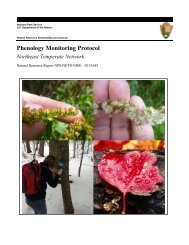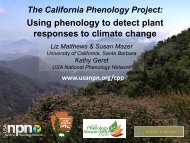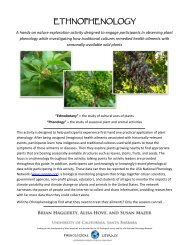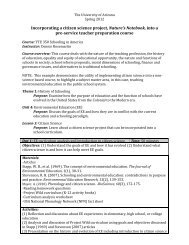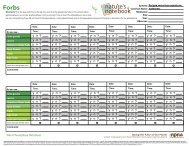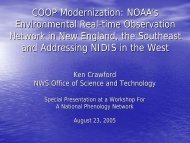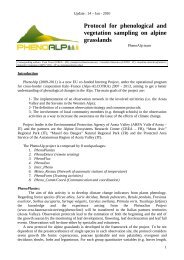The Phenology Handbook - USA National Phenology Network
The Phenology Handbook - USA National Phenology Network
The Phenology Handbook - USA National Phenology Network
You also want an ePaper? Increase the reach of your titles
YUMPU automatically turns print PDFs into web optimized ePapers that Google loves.
Community-level phenology - what does it tell us?<br />
What does the phenology of ecological communities tell us beyond its approximate time schedule? To start, it<br />
describes the availability of resources in the community and sheds light on which species might be interacting<br />
most strongly with other species. For example, in the community represented by Figure 5, the two species of<br />
plants that were still flowering in July could be visited by only one species of insect pollinator (at least, among<br />
those pollinators observed); if this pollinator prefers to forage for pollen and nectar in one species over the<br />
other, then fruit and seed production of the neglected species is likely to suffer.<br />
As a more complex example, the abundance of insectivorous bird species is highest in March and the foraging activities<br />
of these birds is likely to reduce the abundance of insect pollinators. This may, in turn, reduce pollination<br />
services for the plants that are in flower at that time, which could result in many flowers being left unpollinated.<br />
This reduction in pollination could then lead to a decrease in the availability of ripe fruits for the three species<br />
of frugivorous birds that appear later in the spring. If three species of frugivorous birds are actively foraging for<br />
a limited supply of fruits, then competitive interactions among them are likely to be intense, and this could potentially<br />
affect the reproductive success of either individual birds or an entire population.<br />
Overall, ecological communities are dynamic assemblages of coexisting species that interact both directly and<br />
indirectly over time. Thus, the phenology of communities provides a measure of their diversity and productivity,<br />
the combination of which can contribute to the long-term stability of the community.<br />
Phenological variation among communities (across landscapes, continents, hemispheres, and the globe)<br />
<strong>The</strong> detection of phenological patterns across ecological communities and across broad geographic scales plays<br />
an important role in our understanding of global environmental changes. <strong>The</strong> recent development of new remote<br />
sensing technologies (e.g., satellite-based observations) as well as new information-sharing and analytical<br />
tools has enabled the integration of historically disparate environmental sciences (more about this later). <strong>The</strong><br />
resulting multidisciplinary approach has led to the development of large databases that provide layers of information<br />
on physical, chemical, and biological processes across a variety of geographic scales. <strong>The</strong>se efforts have<br />
helped to develop a stronger understanding of how environmental conditions, especially the climate system,<br />
10<br />
<strong>Phenology</strong> can also be examined at the level of the flower within an individual. This series of images of California<br />
Brittlebrush (Encelia californica) shows the phenological progression of one sunflower, from a young bud on the left<br />
to a withered flower on the right (a withered flower, also called a “spent” flower, usually indicates that the flower was<br />
pollinated and is maturing its seeds). Similar to the previous examples that quantify and describe the amount of variation<br />
of first flowering date, there can be variation among individuals, populations, and species for the rate at which<br />
individual flowers open, wilt, and mature seeds. Can you remember the three sources of variation that are likely to<br />
influence phenological traits?<br />
You might be surprised to know that a sunflower is actually a collection of many small flowers (called an “inflorescence”)!<br />
Each of the large yellow “petals” is part of an individual “ray flower”, and each yellow strand in the middle is<br />
part of an individual “disk flower”. Notice in this phenological progression that ray flowers mature first, followed by the<br />
outermost disc flowers, and finally the innermost disc flowers. Can you detect the difference between fresh and wilted<br />
flowers on this sunflower inflorescence? This same inward progression is common to many species of sunflowers - take<br />
a close look the next time you see some in your yard, at the market, and at the florist’s shop!



